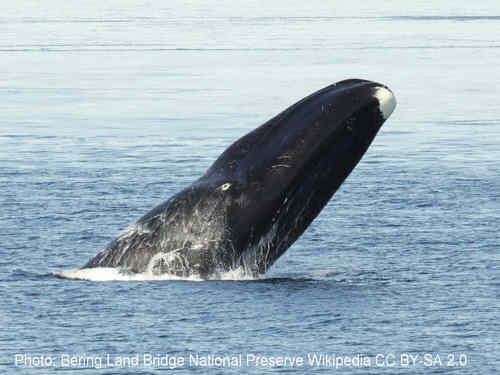Bowhead Whale (Balaena mysticetus)

Appearance
The bowhead whale is a massive baleen whale recognizable by its enormous arched skull, thick blubber layer, and lack of a dorsal fin. Adults typically measure 14–18 meters, with exceptionally large individuals exceeding 20 meters. Body mass commonly ranges from several tens of tonnes up to over 70 tonnes. The skin is dark slate to black with a white chin patch. Bowheads possess the longest baleen plates among whales, reaching several meters and forming a dense curtain for filtering tiny prey.
Distribution
Bowheads occur in the Arctic and sub-Arctic across several management stocks, including the Bering–Chukchi–Beaufort seas, the Sea of Okhotsk, the Canadian Arctic and West Greenland, and the East Greenland–Svalbard–Barents region. They remain in high latitudes year-round, tracking the seasonal expansion and retreat of sea ice.
Habitat
A true ice-associated whale, the bowhead frequents pack-ice margins, leads, and polynyas. Its reinforced skull allows it to break thin sea ice to breathe. The species uses shallow continental shelves and shelf breaks where zooplankton concentrates, but it also moves through deeper basins along ice edges.
Behavior
Bowheads are strong vocalists, producing complex songs and calls that travel long distances under ice. Group size is usually small (solitary to small groups), but loose aggregations can form on productive feeding grounds. Seasonal movements follow sea-ice dynamics and prey availability, with spring and autumn migrations along traditional routes. Surface activity may include breaching and tail slapping despite their bulk.
Diet
They are specialist filter feeders targeting small zooplankton—especially copepods and euphausiids (krill). Using long baleen plates, bowheads skim or gulp dense patches and expel water through the baleen, retaining prey. Feeding intensity often peaks in late spring to summer when plankton blooms occur near ice edges.
Reproduction
Mating occurs mainly in late winter to spring. After a gestation of roughly 13–14 months, a single calf is born (often in spring). Newborns measure around 4–4.5 meters and are weaned after several months. Females likely calve at multi-year intervals, reflecting the species’ slow life history. Sexual maturity is reached relatively late compared to smaller cetaceans.
Threats
Overall recovery has occurred for some stocks since the cessation and regulation of commercial whaling, yet several pressures remain. Key threats include climate-driven sea-ice loss altering prey fields and migration corridors, increased industrial activity and shipping in the Arctic (noise, strike risk), and fishing-gear entanglement in some areas. Indigenous subsistence hunts are regulated. Conservation status is generally favourable at the species level, while certain regional stocks are of higher concern.
Bowhead Whale Facts – Arctic Longevity Champion
The bowhead whale is famed for its exceptional lifespan, with credible evidence of individuals exceeding 150–200 years. Its baleen plates are among the longest of any whale, optimized for sieving tiny prey in frigid seas.
Population and Conservation
Global numbers have increased from historical lows; the largest stock in the eastern Pacific/Western Arctic has shown sustained growth. The species is widely regarded as recovered in parts of its range, though some subpopulations remain small and require continued monitoring.
Interesting Facts
- Bowheads can break thin sea ice with their skull to access breathing holes.
- They lack a dorsal fin—an adaptation advantageous for life under ice.
- Arctic soundscapes carry their songs over long distances beneath the ice cover.
FAQs about Bowhead Whales
How long do bowhead whales live?
They can surpass 150 years; some evidence points to lifespans over 200 years.
Where do bowhead whales live?
In Arctic and sub-Arctic waters of the Northern Hemisphere, closely tied to sea ice year-round.
